Trace Elements Clean Lab
The WSLH provides analysis of most ultra-trace elements, metals, and low-level mercury (both total and methyl) to meet the needs of university and governmental agency researchers. The WSLH can provide a full package from ultra-trace metals sampling using “Clean Sampling Protocol,” pioneered by the University of Wisconsin, for analysis in our state-of-the-art Trace Element Clean Laboratory (TECL) using standard protocols and EPA 1600 series methods to generate data with rigorous QA/QC checks and review. WSLH staff will work with prospective researchers to identify the appropriate analytical techniques required to meet the data quality objectives desired. We analyze both clinical (blood, urine) and environmental (water, soil, aerosol, tissue) samples.
For more information, please contact us by email
Unique Facilities
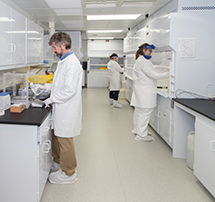 The TECL was designed to permit the analysis of ultra-trace metals in environmental samples at the part per trillion (ppt) levels.
The TECL was designed to permit the analysis of ultra-trace metals in environmental samples at the part per trillion (ppt) levels.
Overall design is equivalent to class 5000, although operational below class 500 and work zones equivalent to class 10. All supply air to room is HEPA-filtered and maintains the room at positive pressure. An anteroom isolates the TECL from the rest of the building. Room air is routinely monitored for particle counts and other environmental variables.
- Constructed from primarily non-metallic materials to minimize metal contamination. Any exposed metal components are epoxy coated.
- Houses three state-of-the-art ICP-MS instruments for ultra-trace metals analysis, and two research-grade atomic flourescence spectrophotometers for low-
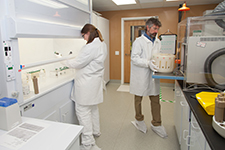 level mercury anlaysis.
level mercury anlaysis. - Contains all-plastic cabinetry, four HEPA-filtered polypropylene exhausting hoods (bio-safety cabinets), three polypropylene exhausting hoods, and five high purity water polishing systems.
- Utilizes two Milestone Ethos EZ Micowave digestion systems to thoroughly liquify solid phase samples prior to analysis. Other types of sample preparation: water extaction or resin separation are also available.
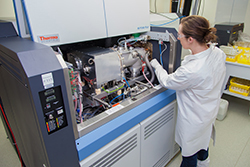 Thermo Scientific Neptune Plus Multi-collector (MC) ICP-MS
Thermo Scientific Neptune Plus Multi-collector (MC) ICP-MS
The Neptune Plus is a multi-collector (MC), magnetic sector (high resolution) and inductively coupled plasma mass spectrometer (ICP-MS) that provides ultra-high-precision stable isotope ratio measurements.
Designed for stable isotope fingerprinting of traditional (Nd, Pb, Sr, Th, U) and non-traditional (Ca, Cd, Cr, Cu, Fe, Zn) isotopes in both environmental and clinical matrices.
- Double-focusing mass spectrometer with high mass resolution
- 8 Faraday and 4 Ion-counter detectors
- Established resin-separation methods to isolate isotopes of interest
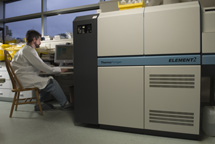 Thermo Scientific ELEMENT2 High Resolution ICP-MS
Thermo Scientific ELEMENT2 High Resolution ICP-MS
The ELEMENT2 is a high-performance, double-focusing magnetic sector ICP-MS capable of high mass resolution at sub ppt range and is ideal for many research applications.
Able to resolve polyatomic interferences of isotopes originating from Argon and/or the sample matrices through high mass resolution.
- Interference-free measurement of almost the entire periodic table
- Several types of nebulizers on hand to properly optimize sample introduction
- Equipped with ESI SE-C2 FAST autosampler for high sample throughput
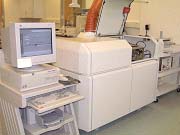 VG PQ ExCell ICP-MS
VG PQ ExCell ICP-MS
The VG PQ ExCell PlasmaQuad is a powerful and flexible quadrapole-based ICP-MS systems. The instrument is a very sensitive multi-element instrument capable of quantification of a wide range of trace elements at the ppt level.
- Fully automated infinity lens which reduces background noise to 0.1 CPS and high signal-to-noise ratio.
- Peltier-stabilized, inert, sample introduction system with low memory effects.
- Collision cell technology enables the selective attenuation of many of the traditionally problematic polyatomic interferences.
- PlasmaScreen technology to aid in determining low-level iron, calcium and potassium.
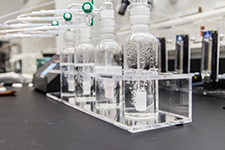 Cold-Vapor Atomic Fluorescence Spectrometer (CVAFS)
Cold-Vapor Atomic Fluorescence Spectrometer (CVAFS)
We have two research-grade Brooks-Rand instruments dedicated to low-level mercury analysis. We routinely analyze water, biological matter and soils.
- One detector utilizes gold trap amalgam techniques for total mercury analysis and improved detection to 0.1 ng/L.
- We routinely follow EPA method 1631 for total mercury analysis of water, and also have methods to analyze soil, hair, plant and animal tissue.
- Our second detector utilizes Tenax traps for methyl mercury analysis in the pg/L range.
- EPA method 1630 is followed for methyl mercury analysis of water.
- We also analyze methyl mercury in tissue and soils.
- Our 24-position methyl mercury distillation block can accommodate a large number of aqueous sample requests.